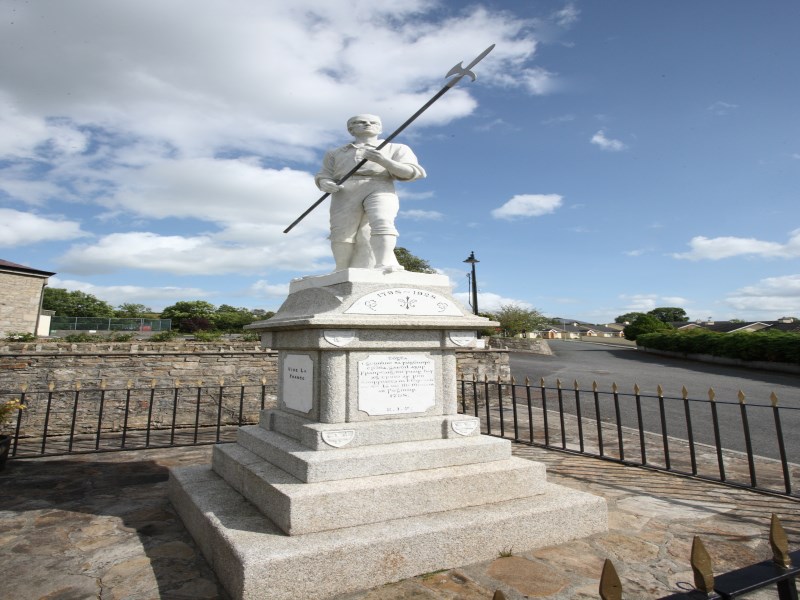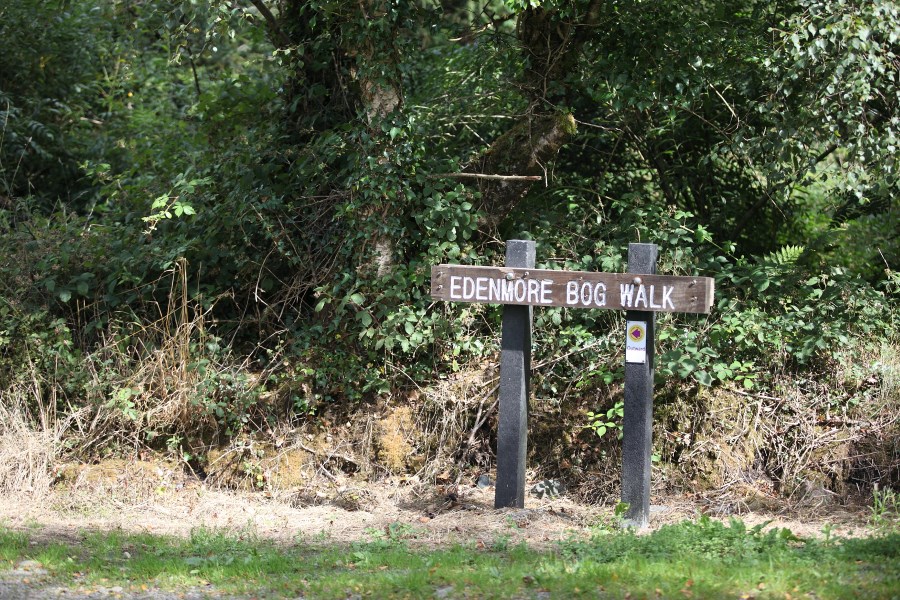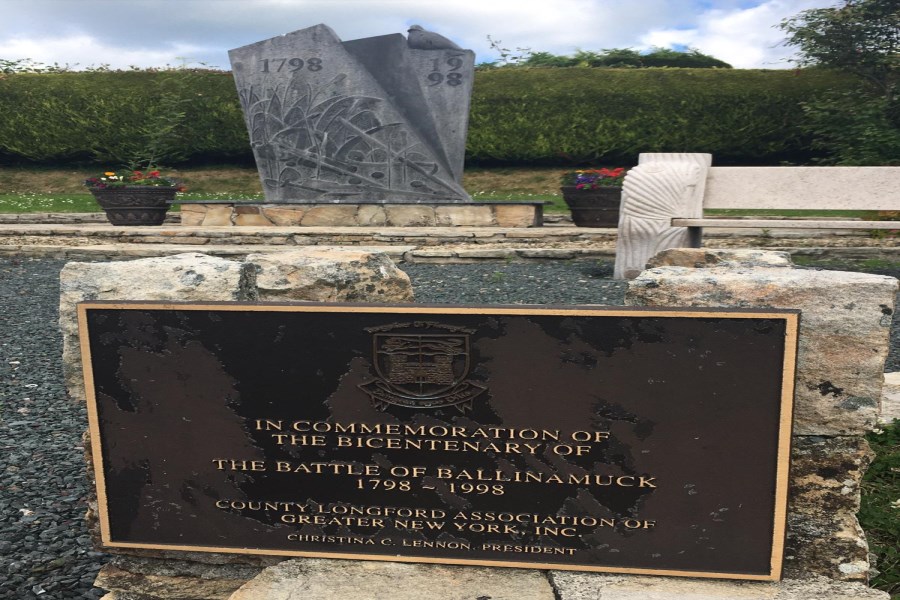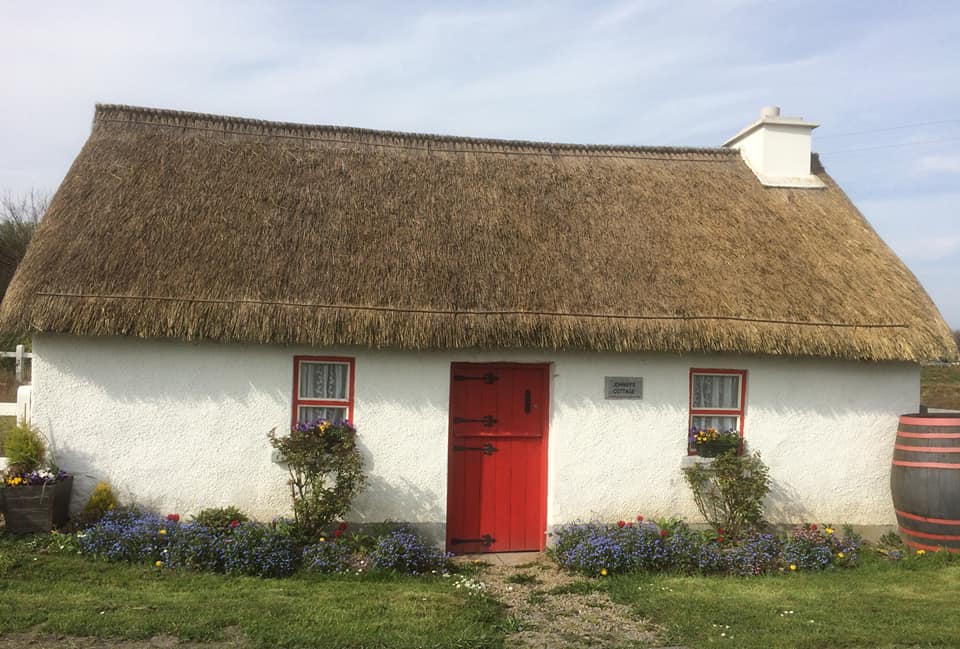Ballinamuck

Ballinamuck is one of the most historic towns in Longford due to a battle fought there in 1798. The Battle of Ballinamuck pitted the combined Irish and French forces under General Humbert and General Blake against the English under Lord Cornwallis.
The battle at Ballinamuck marked the heavy defeat of the main force of the French incursion during the 1798 rebellion in Ireland. Today, a memorial statue of a rebel pikeman (erected in 1928) dominates the centre of the village. In recent years, the village has benefited (in terms of fame) from the success of Thomas Flanagan's historic novel The Year of the French and the subsequent film.
The name Ballinamuck is derived from the original Irish language name Beal Atha na Muice, which means 'the mouth of the ford of the pig'. According to legend, a famous black pig rooted up a trench, from the Dane's Cast in Armagh through Ballinamuck until it arrived at the Ford of Lough Gowna, where a man struck it with a stone and thus put an end to the pig's rooting!
Things to Do

Edenmore Bog Walk
A 4.5km looped walk developed by the Ballinamuck Community Enterprise Group. Edenmore Bog is one of a network of ‘Raised Bogs’ that can be found throughout the midlands of Ireland. Raised Bogs are highly acidic, waterlogged and nutrient-deprived habitats which support a range of specialised plants and animals. This habitat has become very rare in Europe. For further info see edenmore-bog-walk.
The centre of Edenmore bog is in relatively pristine condition, and supports two rare mosses that are only found on high quality raised bog. The edges of the bog support a range of woodland, grassland and wetland habitats, which add to the diversity of flora and fauna in the area.
Tubberpatrick
Located only 5km north of Ballinamuck in County Longford, the cemetery at Tubberpatrick contains interesting memorials to honour General Blake and Gunner Magee, both involved in the Battle of Ballinamuck against the English in 1798. The two men were executed and buried following the defeat of the Irish.
This long-established graveyard contains an interesting collection of mainly 19th and 20th-century grave markers, some of which are of artistic merit, including a number of cut stone Celtic high cross-style and obelisk-type memorials. The earliest legible grave marker dates to 1670 and commemorates Jacobus Farrel.
The graveyard site itself probably dates to well before 17AD and contains a number of archaeological sites, including a holy well, a holy hawthorn tree/bush tied with rags, and a number of mounds. The plan of the graveyard also suggests that this may have been the site of an early church.
The graveyard contains the remains of General George Blake, commander of the United Irishman forces at the Battle of Ballinamuck in 1798. Blake was executed near the battlefield and later buried at this site. This graveyard site is an integral element of the social heritage of the Ballinamuck area, adding historic interest to its rural location. The simple boundary walls, the attractive ashlar gate piers, and the wrought iron gates complete the setting of this interesting composition. The burial ground and holy well are open to the public.
Garden of Remembrance

The Garden of Remembrance was opened in 1998 on the site of the old court house to commemorate the bicentenary of the Battle of Ballinamuck on 8 September 1798. Following on the Irish Rebellion of 1798, a French invasion force landed near Killala in County Mayo on August 22, hoping to join forces with Irish rebels.
After some initial successes, the French force of about 1000 men were confronted by overwhelmingly greater numbers of British troops at Ballinamuck and shortly surrendered. An Irish irregular force, including Irish deserters from the British army, continued to fight on and suffered heavy casualties. Whereas the French prisoners were treated honourably and repatriated, some 200 Irish including their General George Blake were hanged as traitors. For more info see garden-of-remembrance-ballinamuck
1798 Visitors Centre
The 1798 Visitors Centre presents a lively exhibition which gives details of the Year of the French and the Battle of Ballinamuck which took place in 1798.
It is located in the historic former Royal Irish Constabulary barracks. The centre was officially opened by Mary McAleese, then President of Ireland, in July 1999 and houses a fascinating exhibition.
The fateful events of the Battle of Ballinamuck on the 8th of September 1798 are vividly presented with eyewitness accounts from local people and officers of the opposing armies. The exhibition explains the background to these events and the national and international significance of the collision of forces around Ballinamuck.
After learning about the impressive history of the area you may tread the ground where the battle took place, visiting the many historically significant sites.
Opening times vary so please contact before travelling. For more information please see 1798 Visitor Centre.

Johnny's Cottage
So named after a local man Johnny Reilly who along with his wife Linda, donated the once rundown building. This 200 year old cottage had been lovingly restored by members of the Ballinamuck Enhancement and the Ballinamuck Olde Fair committees. It's a lovely sight as you drive through the village on your way down to the '98 bar which also has a Thatched Roof. The cottage is a focal point for Ballinamuck Fair Day activities including storytelling, butter making demonstrations, bread making and traditional cooking. It also has its own lovely biodiversity garden. Johnny's Cottage was voted Longord's Favourite Building 2021 by readers of the Longford Leader newspaper.
Useful links: www.ballinamuck.ie



